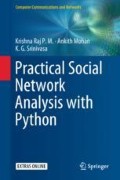Abstract
In Chap. , we learnt that real-world graphs are no way random since random graphs do not exhibit the require degree distribution and clustering coefficient. This means that to explain the required properties of a real-world graph, a different null model is required. In this chapter, we will look at the Milgram’s experiments, the Columbia small world study and other similar experiments. From these experiments, we will learn the well-known small world phenomenon. We will also look at graph models that generate graphs which exhibit this phenomenon, mainly focusing on the Watts–Strogatz model and Kleinberg model. By describing case studies such as the HP Labs studies Adamic, Adar (Social networks 27 (3): 187–203, 2005, [1]), LiveJournal network Liben-Nowell et al (Proceedings of the national academy of sciences of the United States of America 102 (33): 11623–11628, 2005, [12]) and the human wayfinding study West, Leskovec (Human wayfinding in information networks. In Proceedings of the 21st international conference on World Wide Web, 2012, 619–628. ACM, [18]), we will look at how small-world phenomenon is unwittingly being exhibited in the real world.
Access this chapter
Tax calculation will be finalised at checkout
Purchases are for personal use only
References
Adamic, Lada, and Eytan Adar. 2005. How to search a social network. Social Networks 27 (3): 187–203.
Adamic, Lada A., Rajan M. Lukose, Amit R. Puniyani, and Bernardo A. Huberman. 2001. Search in power-law networks. Physical Review E 64 (4): 046135.
Beck, M., and P. Cadamagnani. 1968. The extent of intra-and inter-social group contact in the American society. Unpublished manuscript, Stanley Milgram Papers, Manuscripts and Archives, Yale University.
Dodds, Peter Sheridan, Roby Muhamad, and Duncan J. Watts. 2003. An experimental study of search in global social networks. Science 301 (5634): 827–829.
Horvitz, Eric, and Jure Leskovec. 2007. Planetary-scale views on an instant-messaging network. Redmond-USA: Microsoft research Technical report.
Killworth, Peter D., and H. Russell Bernard. 1978. The reversal small-world experiment. Social Networks 1 (2): 159–192.
Killworth, Peter D., Christopher McCarty, H. Russell Bernard, and Mark House. 2006. The accuracy of small world chains in social networks. Social Networks 28 (1): 85–96.
Kleinberg, Jon. 2000. The small-world phenomenon: An algorithmic perspective. In Proceedings of the thirty-second annual ACM symposium on theory of computing, 163–170. ACM.
Kleinberg, Jon M. 2002. Small-world phenomena and the dynamics of information. In Advances in neural information processing systems, 431–438.
Kleinfeld, Judith. 2002. Could it be a big world after all? the six degrees of separation myth. Society 12:5–2.
Korte, Charles, and Stanley Milgram. 1970. Acquaintance networks between racial groups: Application of the small world method. Journal of Personality and Social Psychology 15 (2): 101.
Liben-Nowell, David, Jasmine Novak, Ravi Kumar, Prabhakar Raghavan, and Andrew Tomkins. 2005. Geographic routing in social networks. Proceedings of the National Academy of Sciences of the United States of America 102 (33): 11623–11628.
Lin, Nan, Paul Dayton, and Peter Greenwald. 1977. The urban communication network and social stratification: A small world experiment. Annals of the International Communication Association 1 (1): 107–119.
Sandberg, Oskar, and Ian Clarke. 2006. The evolution of navigable small-world networks. arXiv:cs/0607025.
Travers, Jeffrey, and Stanley Milgram. 1967. The small world problem. Phychology Today 1 (1): 61–67.
Travers, Jeffrey, and Stanley Milgram. 1977. An experimental study of the small world problem. Social Networks, 179–197. Elsevier.
West, Robert, and Jure Leskovec. 2012. Automatic versus human navigation in information networks. ICWSM.
West, Robert, and Jure Leskovec. 2012. Human wayfinding in information networks. In Proceedings of the 21st international conference on World Wide Web, 619–628. ACM.
Author information
Authors and Affiliations
Corresponding author
Problems
Problems
Download the General Relativity and Quantum Cosmology collaboration network available at https://snap.stanford.edu/data/ca-GrQc.txt.gz.
For the graph corresponding to this dataset (which will be referred to as real world graph), generate a small world graph and compute the following network parameters:
33
Degree distribution
34
Short path length distribution
35
Clustering coefficient distribution
36
WCC size distribution
37
For each of these distributions, state whether or not the small world model has the same property as the real world graph
38
Is the small world graph generator capable of generating graphs that are representative of real world graphs?
Rights and permissions
Copyright information
© 2018 Springer Nature Switzerland AG
About this chapter
Cite this chapter
Raj P. M., K., Mohan, A., Srinivasa, K.G. (2018). Small World Phenomena. In: Practical Social Network Analysis with Python. Computer Communications and Networks. Springer, Cham. https://doi.org/10.1007/978-3-319-96746-2_4
Download citation
DOI: https://doi.org/10.1007/978-3-319-96746-2_4
Published:
Publisher Name: Springer, Cham
Print ISBN: 978-3-319-96745-5
Online ISBN: 978-3-319-96746-2
eBook Packages: Computer ScienceComputer Science (R0)

